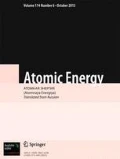Literature Cited
I. A. Varovin, A. P. Eperin, M. P. Umanets, and V. G. Shcherbina, “Ten-year experience of operating the Leningrad NPP,” At. Énerg.,55, No. 6, 349 (1983).
M. E. Shitsman, Yu. I. Timofeev, L. S. Midler, et al., “27,000 h of the NRG operation without serivce acid washing,” Énergetik, No. 12, 4 (1978).
Yu. A. Egorov and I. Ya. Emel'yanov, “The state and problems of studying the radiation safety at the NPP in connection with further development of nuclear power,” in: Radiation Safety and Protection at the NPP [in Russian], Énergoizdat,7, Mosocw (1982), p. 5.
Yu. A. Egorov, A. A. Noskov, V. P. Sklyarov, et al., “The study and use of the TRAKT-1 model for calculation of the corrosion products activity in the technological circuit of the NPP with a channel-type reactor,” ibid., Atomizdat,5, Moscow (1981), p. 5.
V. S. Grechishkin, Yu. A. Egorov, G. N. Krasnozhen, et al., “Radiation Conditions at the Chernobyl'skaya NPP in the Initial Operation Period,” ibid., Énergoizdat,7, Moscow (1982), p. 92.
N. I. Bogdanov, A. V. Borunova, Yu. A. Egorov, et al., “Corrosion Products in the CCL (Controlled Circulation Loop) of the NPP with the RBMK Reactor,” ibid., Énergoizdat,8, Moscow (1984), p. 22.
E. P. Anan'ev, A. B. Andreeva, I. S. Dubrovskii, et al., “Efficiency of using the neutral-oxygen water chemistry regime in operating the NPP boiling shell-type reactor,” At. Énerg.,52, No. 1, 10–14 (1982).
N. I. Gruzdev, Z. V. Deeva, B. É. Shkol'nikova, et al., “Possibility of the development of brittle fractures in the heat boiler surface in the neutral-oxidizing regime,” Teploénergetika, No. 7, 8 (1983).
V. I. Gorin, “Some results of operating power units at supercritical pressure in neutral-oxidizing water regime” ibid. p. 2.
N. A. Lyashevich, “Operation reliability of heat surfaces of power units in the water regime with the oxidant dosage,” ibid., p. 11.
G. P. Sutotskii, G. V. Vasilenko, Yu. V. Zenkevich, et al., “Water chemistry regimes of SCP (supercritical pressure) units,” in: Water Treatment and Water Chemistry and Corrosion of the SPP and NPP [in Russian], TsKTI (Tsentr. NIiPKkotloturbinnyi Inst.),158, Leningrad (1978), p. 20.
A. I. Zabelin, A. B. Andreeva, Yu. V. Chechetkin, et al., “Corrosion and Activation in the Circuit of the NPP with a Boiling Reactor in Neutral Water Chemistry Regime without Correction,” Preprint 364 [in Russian], NIIAR-5, Dimitrovgrad (1979), pp. 1–14.
A. I. Zabelin, A. B. Andreeva, V. M. Eshcherkin, et al., “Use of carbon steel in the water chemistry regime without correction of the NPP VK-50” At. Énerg.,49, No. 4, 229–232 (1980).
A. I. Zabelin, “Study of Water Chemistry Regimes of the NPP VK-50,” Preprint 538 [in Russian], NIIAR-23, Dimitrovgrad (1982).
V. V. Gerasimov, Steel Corrosion in Neutral Water Media [in Russian], Metallurgiya, Moscow (1981).
V. V. Gerasimov, Corrosion of Reactor Materials [in Russian], Atomizdat, Moscow (1981).
J. Mushima, “Water chemistry in the Japanese light water reactors,” in: Proc. IAEA Specialists Meetings on Influence of Power Reactor Water Chemsitry on Fuel Cladding Reliability. Italy, Pisa, 12–16 Oct. 1981. Vienna: IAEA, 1982, p. 230.
J. Danko and K. Stahlkopf, “An overview of boiling water reactor pipe cracking,” J. Pressure Vessels and Piping, No. 9, 401–419 (1981).
C. Cheng, “Intergranular stress-assisted corrosion cracking of austenitic alloys in water-cooled nuclear reactors,” J. Nucl. Mater.,57, No. 11 (1975).
W. Casto, “Recent occurrences at nuclear reactors and their causes,” Nucl. Safety,15, No. 4, 466–477 (1974).
W. Casto, “Recent occurrences at nuclear reactors and their causes,” ibid., No. 6 742–750
“Pipe cracking in boiling water reactors,” Nuclear Regulatory Commission report, Nucl. Safety,17, No. 4, 475 (1976).
D. Locke, “Review of experience with water reactor fuels 1968–1973,” Nucl. Eng. Design,33 No. 2, 94 (1975).
M. Taylor, “Boiling water reactor stress corrosion cracking of piping-utility industry research program,” ibid.,69, No. 2, 223–227 (1982).
“Hydrogen stops growing cracks in BWRs,” Nucl. Eng. Int.,25, No. 295, 6 (1980).
G. M. Kalinin, “Intercrystalline corrosion cracking and methods of recovering NPP pipelines,” At. Tekh. Rubezhom, No. 1, 17–20 (1985).
O. I. Martynova, “Further development of oxidizing water chemistry regime at power units with direct-flow channels in Western Europe,” Energokhozyaistvo Rubezhom, No. 3, 8–13, (1982).
“Structure materials corrosion under operation regimes of the first loop of the NPP with boiling reactors. Stainless, and pearlitic steels and zirconium alloys,” in: Proc. of the Jubilee Conf. on the Occasion of the 20th Anniversary of Nuclear Power Engineering [in Russian], Obninsk, June 25–27 (1974), p. 201.
A. S. Zaimovskii, A. V. Nikulina, and N. G. Reshetnikov, Zirconium Alloys in Nuclear Power Engineering [in Russian], Énergoizdat, Moscow (1981).
Additional information
Translated from Atomnaya Énergiya, Vol. 59, No. 6, pp. 409–413, December, 1985.
Rights and permissions
About this article
Cite this article
Gerasimov, V.V., Gromova, A.I., Baranov, V.N. et al. Reasons for and against the oxygen dosage in condensate feed circuits of nuclear power plants with RBMK-1000 reactors. At Energy 59, 976–982 (1985). https://doi.org/10.1007/BF01132603
Received:
Issue Date:
DOI: https://doi.org/10.1007/BF01132603

